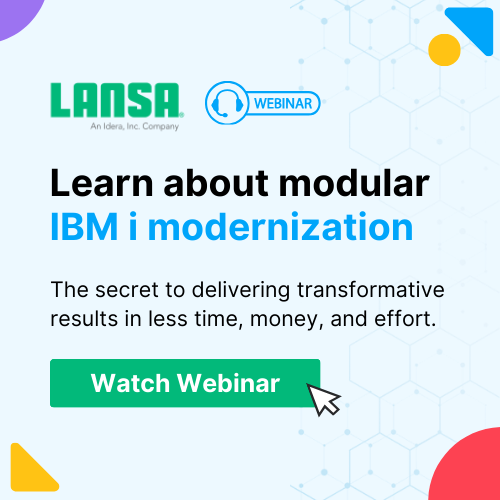Today, in 2022, automation in its various forms is no longer an exciting new trend in the global business environment. The benefits of automating digital and physical work processes have been well-reported and documented. Managers and corporate decision makers are now much more aware about the needs to modernize legacy and implement automation.
So by now, the majority of organizations relying on IBM-powered IT infrastructure realize that legacy systems from the IBM AS/400 era should be replaced. Safe to say that the demand for AS400 automation and IBM i application modernization skills and services today is booming today more than ever.
Why sometimes AS400 automation projects fail
In this environment, AS400 automation and IBM i app modernization projects are often implemented hastily. Without proper planning, by developers who are not equipped with the appropriate tools and/or skills.
Needless to say, rushed and poorly executed modernization projects hardly ever produce great business outcomes. The results of failed AS400 automation are not as widely reported, for obvious reasons. But they are nevertheless as real as the advertised benefits of modernizing IBM i legacy.
Of course, rushing with modernization and poor planning are not valid reasons when it comes to business investments and potential losses. To dig a bit deeper in trying to explain why AS/400 automation projects fail, here are some of the most common mistakes.
Deadliest mistakes of AS400 automation
They occur on different levels of business structure and steps of implementation. This isn’t always the case, but making any of these mistakes can easily sabotage the outcome of an AS400 automation project.
Failure to address the skills shortage problem
One common mistake is initiating AS400 automation and IBM i application modernization projects without having enough qualified employees to implement them. Legacy systems rely on software from the same era, with code written in outdated programming languages. In the case of AS400 automation and IBM i modernization, the code is written in RPG. Many of those green-screen apps are programmed in language used by Synon, a legacy IBM i rapid app development tool.
You can’t automate and modernize these legacy components having no or not enough engineers with knowledge and experience in RPG and other IBM i technologies. Nevertheless, it’s not uncommon for organizations to initiate and start implementing such projects without properly addressing this problem. Which can be solved not just by hiring increasingly rare and very expensive RPG programming experts. Today, it makes a lot more sense to modernize legacy RPG code first, replacing it with a modern object oriented language.
Bad choice of processes to automate
When it comes to AS400 automation, the choice of specific components and processes to automate also plays a major role. If you are dealing with original or partially updated AS/400 legacy systems, it means that architecture and business logic belong to the 1980s era as well.
That’s why automating AS/400 legacy rarely produces the desired business outcome without IBM i application modernization. Ideally, IBM i modernization should come first and include up-to-dating the software architecture and logic of modernized apps.
Inability to properly integrate AS400 automation with internal and external systems
You could say that the most difficult part of automating a business process is not the automation itself. It’s integrating all these automation components into the existing system. Naturally, it is also the case with AS400 automation.
In fact, not being able to properly integrate AS400 automations in business processes is rather common. After an AS400 automation is built, you need to establish the data exchange and process flow execution across multiple IT layers and business systems. The integration of AS400 automations across the internal enterprise network can be challenging due to large diversity of data formats. Connection to external services and platforms is even more difficult to establish.
Poor choice of tools or no investments in modernization tools
The choice of platforms, technologies and specific solutions, naturally, is another central element in any AS400 automation or IBM i modernization project. In some cases, this mistake originates closer to the decision-making level. For example, a modernization project gets approved and financed by top management, but legacy modernization tools investments are not part of the budget.
It’s not uncommon for this mistake also to occur on the IT management level, as a bad choice of tools or development approaches. Which can be a result of limited knowledge of modernization technologies by internal IT staff or them selecting instruments they are most familiar with.
LANSA’s powerful tools for AS400 automation
Visual LANSA is a low-code, rapid application development platform for building enterprise-grade mobile, web and desktop apps. LANSA’s platform has been a key component powering the successful delivery of AS400 automation projects for hundreds of organizations throughout the years.
Using LANSA’s high-level language, the same skills can be applied to write client-side code, server-side code, and everything in between. LANSA saves organizations the expense of hiring costly specialized software developers to deliver a modernization project or create a new app. It allows even developers with limited skills and experience to contribute to the app creation process without worrying about the technical aspects.
LANSA incorporates a variety of powerful tools. Including several instruments that were created for the IBM i platform exclusively.
RAMP (Rapid Application Modernization Process)
Rapid Application Modernization Process (RAMP) is an incremental modernization approach that implements the best of refacing existing applications and new development. By consolidating existing functionality with RAMP, you get to have the apps you want without having to throw everything away. Modernization is performed in stages. New functionality can be introduced incrementally without serious impact to business operations. And the user interface becomes consistent across all of the applications.
LANSA Integrator
LANSA Integrator is a toolset that serves as a strategic middleware for transforming and transporting data across systems and applications. It simplifies exchanging data between applications. Or transferring files and documents from one business to another.
This set of tools and services was developed by LANSA for IBM i users primarily. It provides the developers with everything required to build powerful data integration solutions. Including data transformation, transport and infrastructure. And simplifies integration design by providing the tools needed to receive, extract, transform and send data. Developers only need to define the data, the transformation rules and choose a data transport. Integrator takes care of the detailed work that ensures the data is delivered in the desired format.
LANSA Composer
LANSA Composer is a specialized business process integration suite, designed to handle the integration and process improvement challenges.
LANSA Composer is a simple and cost-effective way to implement AS400 automation with less human effort. It reduces development time by including a set of ready-made activities that most companies need for business process integration. You simply assemble business processes. Assembling a process is much faster than writing program code to manage the process.
Let’s fix those mistakes of AS400 automation?
LANSA’s IBM i modernization tools combine all the right trends in modern-day software development and digital transformation. LANSA is the solution to implement IBM i modernization and AS400 automation quickly, reliably, and with limited resources.
One of LANSA’s solutions created for IBM i users specifically is aXes: one of our IBM i modernization tools. It’s a tailor-made tool designed to automate the creation of web-enabled IBM i applications. It allows organizations to easily transform their existing IBM i 5250 apps into web pages.
aXes includes an API that allows developers to create programs able to automatically operate applications written with RPG or COBOL. Applications can use aXes to simulate the actions of a person entering data on screens in an IBM i application. This feature makes it possible to integrate existing 5250 apps with .NET, Java and other platforms.
Thinking about investing in LANSA’s low-code solutions, but need to ensure they meet all your business requirements? You can get a free Proof of Concept (POC) implemented by LANSA based on your input data. Just fill up the form on our website.
Ready to begin? Get in touch with us to start utilizing Visual LANSA for your app development and modernization needs.










